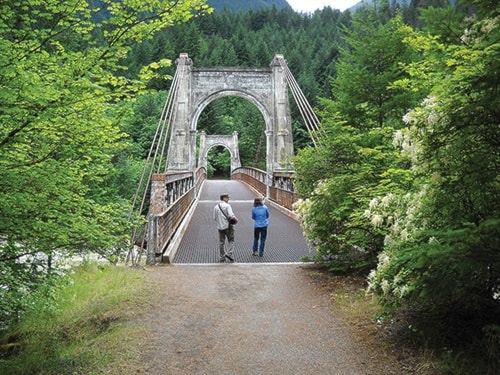The Fraser Canyon Highway takes you through a scenic landscape rich in human history. It’s worth taking time to stop at some of the scenic and historic sites along this ancient path.
First Nations traversed the canyon walls using ropes, ladders and bridges. They built a trail network that connected their villages, enabling trade, hunting, and resource gathering. The Tikwalus Trail (north of Spuzzum) is a native trail that you can hike today, providing spectacular views of the canyon.
The first European to travel the canyon was fur trader Simon Fraser in 1808. Visit Hell’s Gate and you’ll see the sheer granite walls and boiling river that terrified Fraser and his men.
Transportation in the canyon accelerated with the discovery of Fraser River gold in 1858. Mule trails were built up the canyon in 1860 and you can find a section of mule trail near the southern entrance to Hell’s Gate Tunnel. New gold strikes at Barkerville in 1861 forced the colonial government to upgrade the mule trail to a wagon road.
The Cariboo Wagon Road celebrates its 150th anniversary this year. Completed in 1863, the road was built by hand and linked the gold rush boom towns of Fort Yale and Barkerville — a 600 kilometre distance.
The crowning touch of the wagon road was the Alexandra Bridge, which you can still walk over when visiting Alexandra Bridge Provincial Park, 40 kilometres north of Hope on Highway 1.
Two national railways followed in 1885 and 1915. The first automobile road came in 1926, but the modern highway wasn’t completed until the early 1960s.
As you travel the canyon today, you will pass through seven tunnels, ranging in length from about 57 metres to 610 metres. Engineers were forced to blast through canyon rock in order to complete this section of Highway 1.
Fraser River Gold Rush
It was March 23, 1858 when Edward Hill discovered gold at his feet while enjoying lunch. Later named Hill’s Bar, its discovery triggered the Fraser River Gold Rush, and the bar would become the richest gold producer on the entire Fraser River. However, Edward Hill was not really the first person to profit from gold on the Fraser.
First Nations had been quietly mining gold in their territory for at least a decade prior to 1858. Sto:lo and Nlaka’pamux people traded gold, furs, and salmon with the British forts at Hope and Yale, in exchange for valuable goods such as hunting rifles, cooking pots, and steel tools.
Although the British laid claim to the B.C. mainland as a fur trading territory, First Nations held real political power on the ground. They vastly outnumbered Europeans in these early contact years, and Aboriginal economic and cultural traditions flourished in collaboration with the fur traders.
When news of the gold strike at Hill’s Bar reached San Francisco, thousands boarded steamships bound for Fort Victoria. By the summer of 1858, American miners were pouring into the narrow confines of the Fraser Canyon and overrunning First Nation villages. Some miners stole food and property, and assaulted and killed Sto:lo and Nlaka’pamux people. The First Nation communities naturally retaliated in defense of their security and sovereignty. The Canyon War was short and bloody, causing the deaths of dozens of miners and natives. It was only brought to an end by the diplomacy and peacemaking of Nlaka’pamux chief David Spintlum.
The Canyon War, and the sudden influx of American miners into British-claimed territory, forced British authorities to act. They therefore requested a company of soldiers and lobbied London for full colony status.
